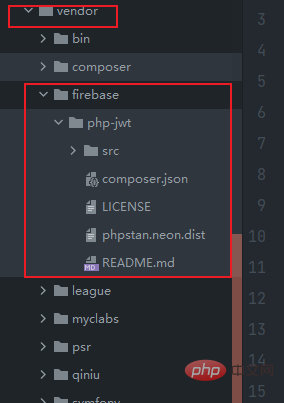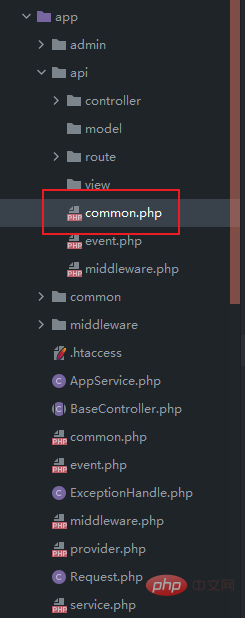
This article brings you relevant knowledge about thinkphp, which mainly introduces the issues of using jwt authentication. Let’s take a look at it together. I hope it will be helpful to everyone.

Recommended study: "PHP Video Tutorial"
composer require firebase/php-jwt

The common.php global file in the project app directory is used and made into a public method. Since I have multiple applications, I wrote it in the common.php under the api. You can adjust it appropriately according to your own needs

<?phpuse \Firebase\JWT\JWT;use Firebase\JWT\Key;// 应用公共文件/**
* 生成验签
* @param $uid 用户id
* @return mixed
*/function signToken($uid){
$key='abcdefg'; //自定义的一个随机字串用户于加密中常用的 盐 salt
$token=array(
"iss"=>$key, //签发者 可以为空
"aud"=>'', //面象的用户,可以为空
"iat"=>time(), //签发时间
"nbf"=>time(), //在什么时候jwt开始生效
"exp"=> time()+30, //token 过期时间
"data"=>[ //记录的uid的信息
'uid'=>$uid,
]
);
$jwt = JWT::encode($token, $key, "HS256"); //生成了 token
return $jwt;}/**
* 验证token
* @param $token
* @return array|int[]
*/function checkToken($token){
$key='abcdefg'; //自定义的一个随机字串用户于加密中常用的 盐 salt
$res['status'] = false;
try {
JWT::$leeway = 60;//当前时间减去60,把时间留点余地
$decoded = JWT::decode($token, new Key($key, 'HS256')); //HS256方式,这里要和签发的时候对应
$arr = (array)$decoded;
$res['status'] = 200;
$res['data'] =(array)$arr['data'];
return $res;
} catch(\Firebase\JWT\SignatureInvalidException $e) { //签名不正确
$res['info'] = "签名不正确";
return $res;
}catch(\Firebase\JWT\BeforeValidException $e) { // 签名在某个时间点之后才能用
$res['info'] = "token失效";
return $res;
}catch(\Firebase\JWT\ExpiredException $e) { // token过期
$res['info'] = "token过期";
return $res;
}catch(Exception $e) { //其他错误
$res['info'] = "未知错误";
return $res;
}} /**
* 使用jwt生成token字符串
*/
public function setJwtToken()
{
$uid = input('uid'); // 接收生成token字符串 如:123
$token = signToken($uid);
// 生成字符串: eyJ0eXAiOiJKV1QiLCJhbGciOiJIUzI1NiJ9.eyJpc3MiOiJhYmNkZWZnIiwiYXVkIjoiIiwiaWF0IjoxNjQxNDUwMTU0LCJuYmYiOjE2NDE0NTAxNTcsImV4cCI6MTY0MTQ1NzM1NCwiZGF0YSI6eyJ1aWQiOiIxMjMifX0.I_GAkMsOhtEpIPkizCuQA-b9H6ovSovWx0AwAYI-b0s
echo $token;die;
}
/**
* 使用jwt验证token字符串
*/
public function checkJwtToken()
{
$token = input('token'); // 接收生成token字符串
$result = checkToken($token);
// Array ( [status] => 200 [data] => Array ( [uid] => 123 ) )
print_r($result);die;
}<?phpdeclare (strict_types = 1);namespace app\api\controller;use think\facade\Db;use think\Request;class User{
public function login(Request $request)
{
if ($request->isPost()){
$username = $request->param('username','','trim');
$password = $request->param('password','','trim');
//查询数据库
$user = Db::name('user')->where('username',$username)->find();
if (!$user){
return json(['status' => 'fail','msg' => '用户名不存在']);
}
if ($user['password']!==md5($password)){
return json(['status' => 'fail','msg' => '密码错误']);
}
$getToken = $this->token($user);
return json(['status' => 'success','msg' => '登陆成功','token' => $getToken]);
}
}
public function token($user)
{
$uid = $user['username']; // 接收生成token字符串 如:123
$token = signToken($uid);
dd($token);
}
/**
* 验证token
*/
public function chToken()
{
$token = 'eyJ0eXAiOiJKV1QiLCJhbGciOiJIUzI1NiJ9.eyJpc3MiOiJhYmNkZWZnIiwiYXVkIjoiIiwiaWF0IjoxNjQ4MDkwMDkyLCJuYmYiOjE2NDgwOTAwOTIsImV4cCI6MTY0ODA5MDEyMiwiZGF0YSI6eyJ1aWQiOiJcdTVmMjBcdTRlMDlcdTk4Y2UifX0.oJFpNcZ6stMymOCbD-meX0IPEIYLYNcwKxhMItF2cMw';
$result = checkToken($token);
// Array ( [status] => 200 [data] => Array ( [uid] => 123 ) )
print_r($result);die;
}}The user logs in successfully and returns to the front end token, the front end stores the token, and carries the token in the header during the next request. The back end accepts the token and verifies it in the middleware
<?phpdeclare (strict_types = 1);namespace app\middleware;class Api{
/**
* 处理请求
*
* @param \think\Request $request
* @param \Closure $next
* @return Response
*/
public function handle($request, \Closure $next)
{
//toke 合法性验证
$header = $request->header();
//判读请求头里有没有token
if(!isset($header['token'])){
return json(['code'=>440,'msg'=>'request must with token']);
}
$token = $header['token'];
try {
// token 合法
$token = checkToken($token);
}catch (\Exception $e){
return json(['code'=>440,'msg'=>'invalid token']);
}
return $next($request);
}}Finally, there are two solutions to how to deal with the issue of token expiration. The first is to set the token time longer so that the token will not expire. However, this has a drawback. Once the client Obtaining this token is equivalent to having a key, and the initiative is in the hands of the user. So this solution is not recommended. The second is back-end processing. When the token expires, the token is reacquired and the new token is passed to the front end. The front end stores the new token, replaces the original token, and carries the new token with the next request. token request.
I am programmer Fengfeng, a programmer who loves learning and tossing.
Recommended learning: "PHP Video Tutorial"
The above is the detailed content of Detailed example of thinkphp6 using jwt authentication. For more information, please follow other related articles on the PHP Chinese website!
 Which one is easier, thinkphp or laravel?
Which one is easier, thinkphp or laravel?
 How is the performance of thinkphp?
How is the performance of thinkphp?
 What are the applications of the Internet of Things?
What are the applications of the Internet of Things?
 The latest prices of the top ten virtual currencies
The latest prices of the top ten virtual currencies
 What to do if the CPU usage is too high
What to do if the CPU usage is too high
 How to run code with vscode
How to run code with vscode
 The difference between a++ and ++a
The difference between a++ and ++a
 Why can't the QQ space web page be opened?
Why can't the QQ space web page be opened?